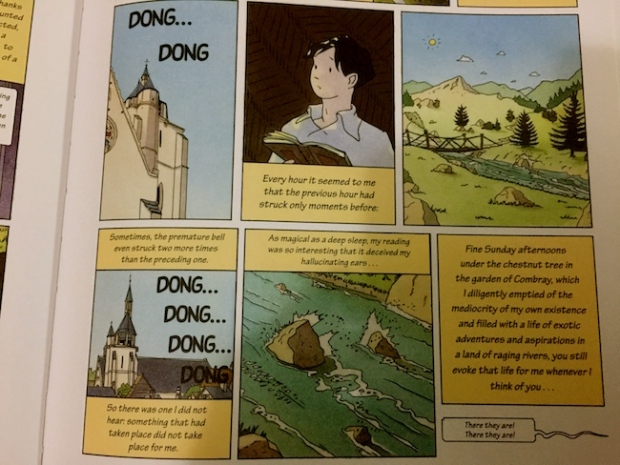It's hard to pin down exactly what I love so much about Proust, especially since I'm a scant book and a half into his great novel, In Search of Lost Time
. Charles Mingus famously said, "it's easy to sound weird," praising the making of the complex simple, as Bach did. Marcel Proust wrote the prototypical 20th-century novel in a style all his own. I'm reading the C.K. Scott Moncrieff translation, which is faulty in some ways, but it is known for capturing the style of Proust, with his long, flowing, beautiful sentences. Proust talks of memory, of time, but mostly he talks about people. You fall in love with his characters, which come to life in volume after volume.
 In Search of Lost Time: Swann's Way, The Graphic Novel
In Search of Lost Time: Swann's Way, The Graphic Novel is the work, primarily, of Stephane Heuet, a French comic artist in the
bandes dessinees (Franco-Belgian) tradition. He has worked on adapting
In Search of Lost Time for almost two decades, and it is only in 2015 that
Swann's Way, the first volume, has been available in English. Arthur Goldhammer translates not Proust but Heuet. Proust in any language is not suitable for comics, one would think, because of those aforementioned long sentences. Heuet takes Proust's language and codifies it, abbreviating it into sentences that can fit into ordinary text boxes. Goldhammer then makes it palpable for the Anglophone audience.
I've seen several reviews of the
Swann's Way audiobook by readers who were introduced to Proust through Heuet's comic, and Goldhammer argues that one of the principal audiences of this graphic novel is people who are too intimidated by Proust to read
In Search of Lost Time in its original or translated form. Well, guess what? Even the graphic novel is intimidating. It's huge, to begin with, and I read it for an hour, only to get a mere 50 pages into it. The artwork is classic
ligne claire, stunning and a triumph. Heuet does things only the discerning reader or fellow artist would appreciate, like staggering panels by mere millimeters, so that the reader knows which way to read without thinking.

Anyway, what Heuet has done is create a gift to all fans of Proust. Of course, it cannot be a perfect adaptation without being thousands of pages long. And who would read it then? The length is excellent in my view, a solid four-hour read (compared to 15 to 20 hours for the prose book), at just over 200 full-sized pages. It has a lot of text for a graphic novel, a LOT of text. I would compare it to one of my favorite novel adaptations,
Ringworld: The Graphic Novel. The adaptation of
Ringworld is six or seven hundred pages in two manga-sized volumes. That adaptation, on the other hand, tries to include everything that is in the book, nearly, at the expense of color.
Swann's Way: The Graphic Novel is lavishly colored, as seen in the attached photographs.







